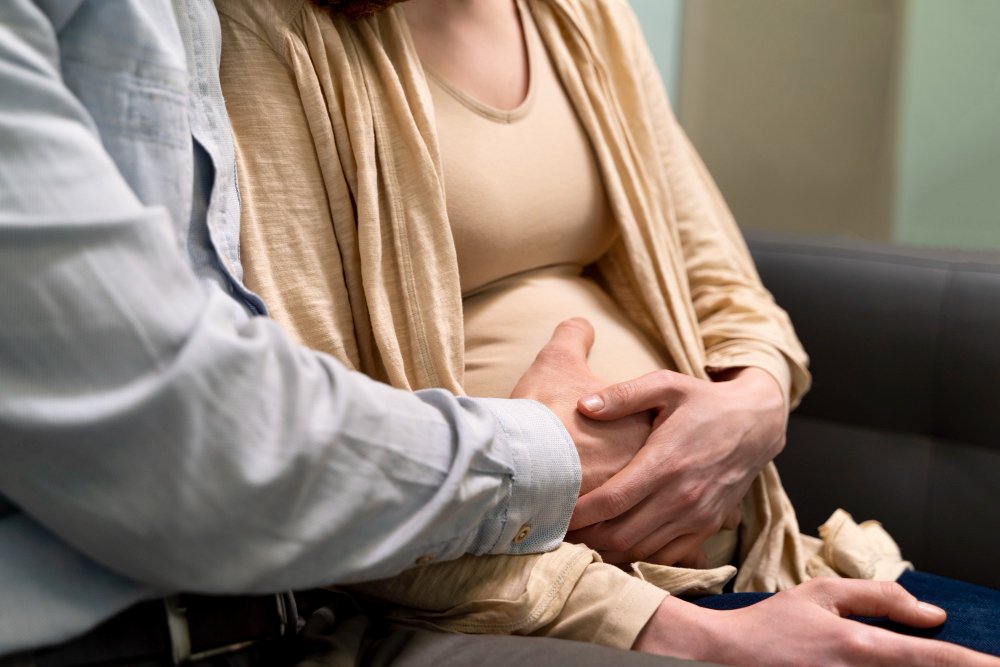The Miraculous Journey of Labor and Delivery
Rebecca Johnson
April 2024
For many young women, the thought of labor and delivery has always been daunting…but the journey is truly astounding, and is separated into multiple stages till birth. The technical term for childbirth is “Parturition”, which is calculated to be 280 days from a woman’s last menstrual period. Now, we are going to walk through each stage and dive deeper into this interesting topic. The definition of labor is the series of events that expel the infant from the birth giver. The whole experience is extremely terrifying, especially if the woman experiences Braxton- Hicks contractions, which are false uterine contractions caused by the peaking of estrogen. The peak of estrogen increases the amount of oxytocin receptors, which inhibits progesterone from calming the uterine muscle during the birth process.

Stage 1: Dilation
The first stage is the dilation stage. During this time, the cervix is 8-10 cm and is fully dilated in 8 to 18 hours. In subsequent pregnancies, the time to full dilation decreases to 5-12 hours. At the end of this stage, the mother will feel the urge to push.[1] This stage creates true contractions, but only until the cervix is fully dilated. At this time, the baby’s head will be pushed against the cervix, and water breaks as the amnion ruptures. Amnion is the inner membrane that surrounds the embryo [2] During pregnancy, the amniotic fluid, which fills the amniotic sac, protects the fetus from injury and temperature changes such as maintaining heat. Since it is soft, it allows the fetus to move freely and assists with musculoskeletal development, lung development, and pressure on the umbilical cord[.4] There are many hormones and chemicals working behind the scenes to make this happen. For example, atural and synthetic prostaglandins help relax cervical muscles to soften the cervix, which makes it easier to dilate.[3]
Stage 2: Expulsion
By the second stage, the cervix will have been fully dilated and prepared for childbirth. Now, it is time for the woman to start pushing her baby out. Although the amount of time this takes will vary with every birth, it typically lasts from 20 minutes to a few hours. This time period will decrease with the second child, and so on.[5] This time is also ideal to get an epidural, because it cannot be given right before the mother gives birth, but must be fully dilated. However, an epidural can be given any time the mother can remain relatively still.[6] The purpose of an epidural is to relieve any intense pain the mother feels while pushing. An epidural can be a steroid or an anesthetic, injected into your spinal nerves. [7] A catheter is the tube that injects the medicine into the spine, as a small tube.[8]
Stage 3: Placental stage
The uterine contractions will continue for about 15 minutes after birth, the placenta detaches from the uterine wall. After it detaches, the doctor will pull the umbilical cord which removes the placenta. During birth, the placenta, a temporary organ, attaches to the uterus, and helps pass oxygen, nutrients, and antibodies from the mother to the baby, while getting rid of wastes from the baby. In the case of twins, identical twins may share a placenta, but fraternal twins have their own placentas. [9]
Reference
[1]The stages of labour and birth. (2020, December 1). Nhs.uk. https://www.nhs.uk/pregnancy/labour-and-birth/what-happens/the-stages-of-labour-and-birth/#:~:text=Your%20cervix%20needs%20to%20open
[2] Redirect Notice. (n.d.). Www.google.com. Retrieved April 12, 2024, from https://www.google.com/url?sa=t&source=web&rct=j&opi=89978449&url=https://www.mayoclinic.org/healthy-lifestyle/labor-and-delivery/in-depth/water-breaking/art-20044142%23:~:text%3DDuring%2520pregnancy%252C%2520your%2520baby%2520is
[3] Redirect Notice. (n.d.). Www.google.com. Retrieved April 12, 2024, from https://www.google.com/url?sa=t&source=web&rct=j&opi=89978449&url=https://my.clevelandclinic.org/health/treatments/22165-cervical-ripening%23:~:text%3DProstaglandins%2520are%2520naturally%2520occurring%2520chemicals
[4] Amniotic fluid Information | Mount Sinai – New York. (n.d.). Mount Sinai Health System. https://www.mountsinai.org/health-library/special-topic/amniotic-fluid#:~:text=Amniotic%20fluid%20surrounds%20the%20growing
[5]Stages of labor. (n.d.). Www.marchofdimes.org. https://www.marchofdimes.org/find-support/topics/birth/stageslabor#:~:text=In%20the%20second%20stage%20of%20labor%2C%20your%20cervix%20is%20fully
[6] “Redirect Notice.” www.google.com/urlsa=t&source=web&rct=j&opi=89978449&url=www.yalemedicine.org/news/epidural-anesthesia%23:~:text%3DA%2520woman%2520can%2520get%2520an. Accessed 26 Apr. 2024.
[7]Cleveland Clinic. (2021, October 14). Epidural: What It Is, Procedure, Risks & Side Effects. Cleveland Clinic. https://my.clevelandclinic.org/health/treatments/21896-epidural
[8] Redirect Notice. (n.d.). Www.google.com. Retrieved April 12, 2024, from https://www.google.com/urlsa=t&source=web&rct=j&opi=89978449&url=https://myhealth.alberta.ca/Health/aftercareinformation/pages/conditions.aspx%3Fhwid%3Dzc2342%23:~:text%3DYou%2520will%2520get%2520a%2520shot
[9]Australia, H. (2023, February 8). About the placenta – role and complications. Www.pregnancybirthbaby.org.au. https://www.pregnancybirthbaby.org.au/about-the-placenta#:~:text=mum%20and%20baby.-





